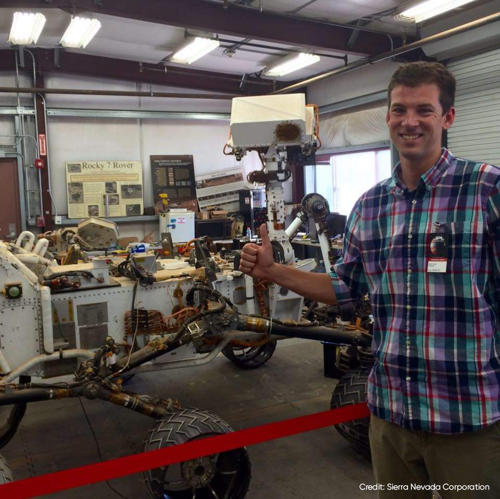Meet Jonathan P., an SNC Engineer Who Worked on Integral Parts for the Mars Perseverance Rover
February 18, 2021
SNC technology was front and center as the Mars Perseverance Rover touched down on the alluvial fan of the 28-mile-wide Jezero Crater and deployed Ingenuity, the first-ever helicopter to fly on another planet.
SNC provided critical components that allowed Perseverance to land on Mars (the descent brake mechanism) and then enabled Ingenuity to take off for its aerial survey (having developed the mechanism that assists in its deployment).
This is the 14th Mars mission that SNC has supported through its critical parts and components, and on this historic mission SNC has eight mechanisms being used in 17 applications on the rover like the robotic arm, turret coring drill and caching assembly.
We chatted with Jonathan P., an engineer who worked on the robotic arms, to find out more about the mission.
Please share a little about what you do at SNC; what is a “day in the life” like?
I work in the Space Technologies group as a mechanical engineer. A typical day could involve working with our CAD designers on a new design, reviewing drawings, analyzing gears/bearings/fasteners and communicating with vendors to find the best solution for the current project. I also work closely with our manufacturing and testing departments to ensure that product can actually be assembled and efficiently tested and help troubleshoot and disposition any part or assembly non-conformances as they arise. I interact with our customers to make sure the product we’re delivering meets their needs and present technical portions during our milestone design reviews. Every day is unique and offers new challenges.
What role did SNC play in the Mars Perseverance rover?
SNC played a very important role in the Perseverance rover. We worked very hard for about three years to conceptualize, design, build, test and deliver over 80 gearmotors in total. While only a fraction of those are actually on the surface of Mars, we had to deliver extras that JPL could use for their testing and validation as well as for spares. The robotic arm joints for this mission needed more torque than prior rovers to be able to hold the heavier drilling assembly. JPL needed a couple of very unique gearmotors within the drilling assembly to spin the drill, feed the drill into the rocks, create the percussion of the drill and finally break off the core samples - which is where we came in. My role was the cognizant engineer over the five larger gearmotor designs using the SNC M45S & M45L motors within the external robotic arm.
Why are the robotic arms integral to a successful rover mission?
This mission is the first of three missions with the goal of returning samples from Mars back to Earth. The robotic arms are critical in order to gather the samples and place them in ultra-clean test tubes to be picked up and launched back to Earth later.
What was it like collaborating with the team to continue fine tuning the arms?
It was very exciting to be collaborating with JPL, the initial concept we got from them was literally a block sketch in Powerpoint, so to go from that to seeing the hardware installed on the working robotic arm first hand, was very rewarding. We had to do a lot of compromising and negotiating between SNC & JPL to get there. One example would be on a couple of the gearmotors, they had very tight clearances to the neighboring parts in the drill assembly, so we had to make some odd-ball looking parts to fit around them. I learned a lot from working with JPL and their team of engineers that will help us to avoid some of the speed bumps we hit the next time around.
Anything else you’d like to add about the program?
Nearly everything about the gearmotors used on the robotic arm was specifically designed for this application. We really had to customize each gearmotor for its end use. The temperature range they had to not only survive, but operate in was the most extreme I’ve ever worked on in my career. It required custom bearings and coatings to meet the demands for torque and life over those extremes all while trying to keep the form factor as small as possible. There are not many industries where you get the opportunity to design something from scratch using custom parts, so I’m very fortunate to work at SNC where we’re allowed the leeway to push the envelope. I’m really proud of the work our whole team put into this project. It’s a shame most of it is covered up by a heat shield on the rover’s arm, but there is a lot of really cool engineering and design under the hood.
If you could explore space with one person, living or dead, who would it be?
I’m not sure I would fit! I’m 6’7” and they told me in 6th grade during a visit to the Marshall Space Flight Center that I was already too tall to be an astronaut! But I’d have to take my wife and daughter. Our family loves adventuring together and that would be the adventure of a lifetime.
---
Interested in joining the Sierra Nevada Corporation team? Apply today at sncorp.com/careers.